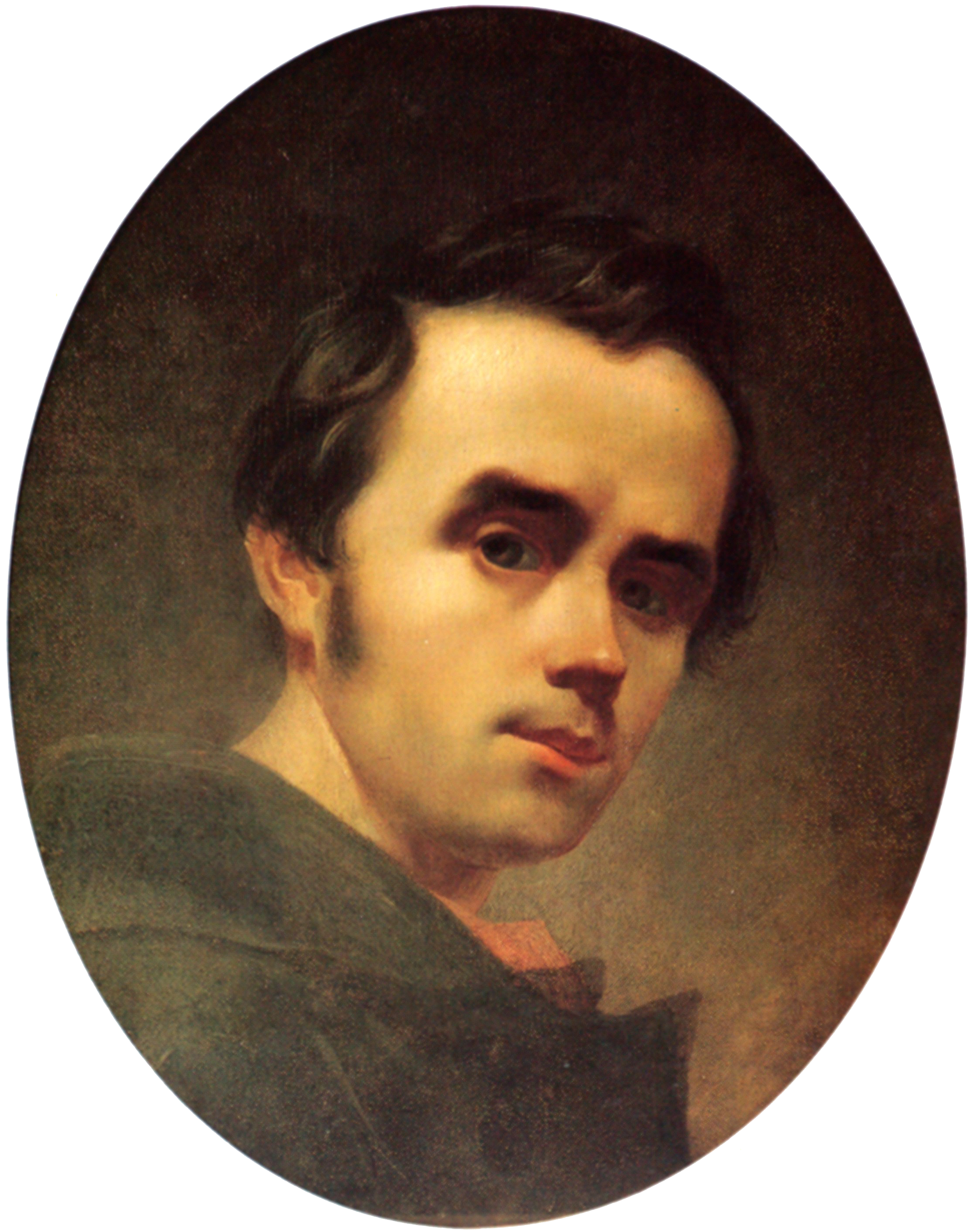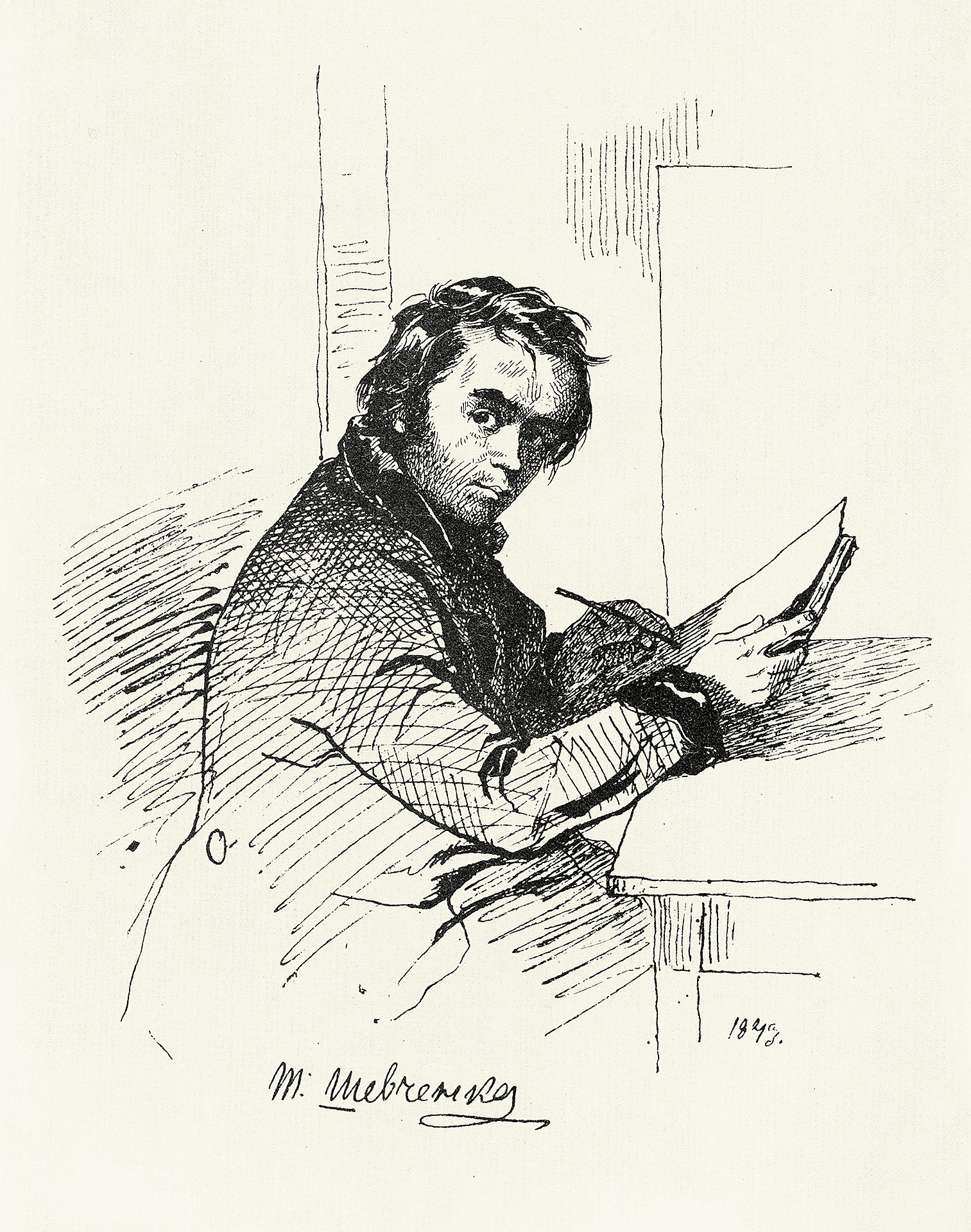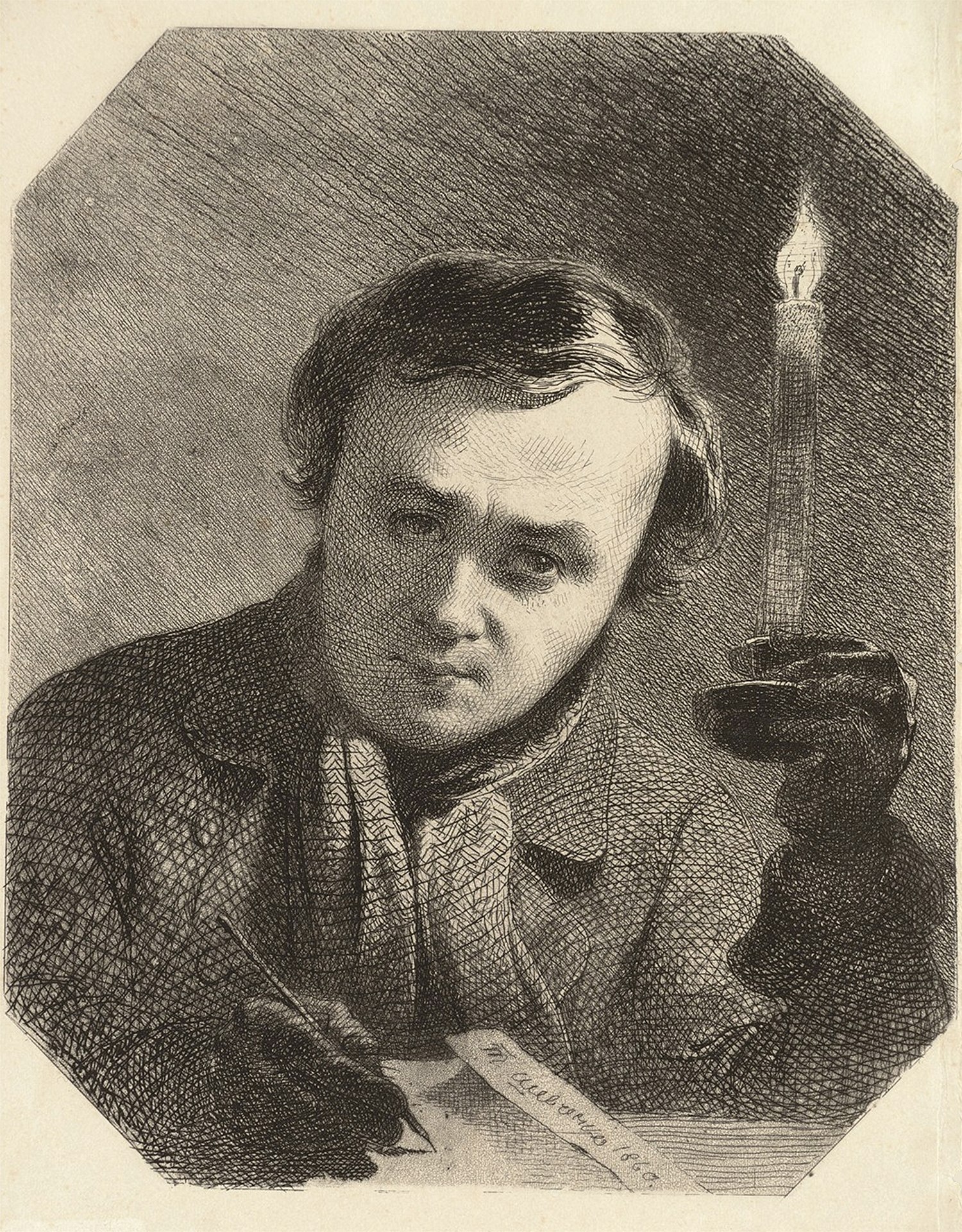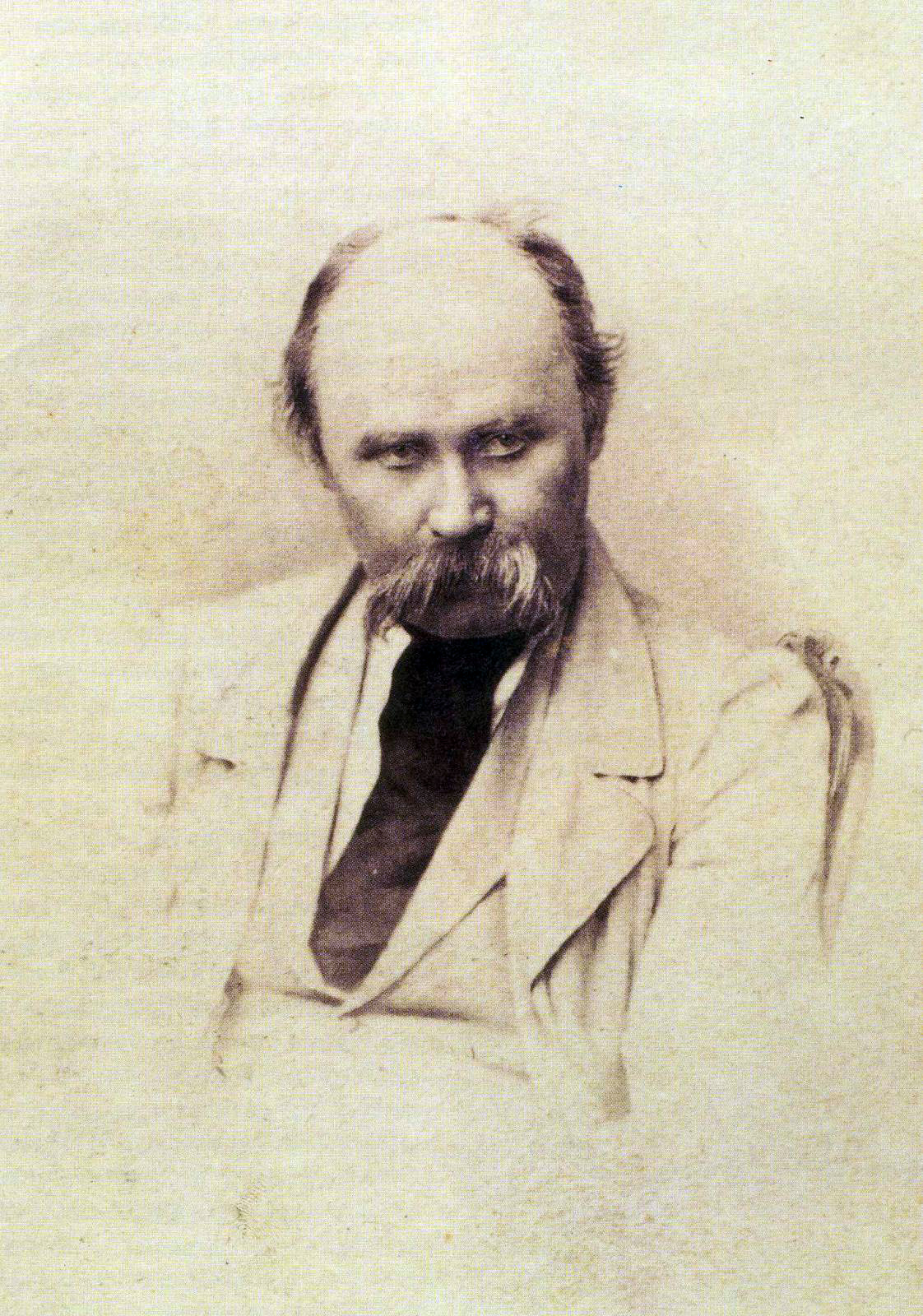AUTOBIOGRAPHY
 Taras Shevchenko, the son of a serf peasant, Grigory Shevchenko, was born on February 25, 1814, in the village of Kirilovka, Zvenigorod district, Kiev Province, on the estate of the landowner Vassily Vassilyevich Engelhardt. When he was going on eight years of age, having lost his father and mother, he found refuge with a church sexton in a school as his pupildrudge. After a most difficult two-year ordeal he learned grammar, the breviary, and finally, the psalm book. The sexton, realising that his pupil-drudge had the ability, used to send him in his stead to read prayers for the souls of serfs who had passed away, for which he paid him every tenth kopeck in remuneration. But despite such flattering attention from his strict Spartan teacher, on one of the many days and nights when the Spartan teacher and his friend Iona Limar were dead drunk, the pupil-drudge, baring the buttocks of his mentor and benefactor, without a twinge of conscience gave him a good dose of the rod. Having avenged himself to the full and purloining a book with pictures, that very night he ran away to the little town of Lisyanka, where he found himself a teacher of painting, a reverend deacon, also a Spartan. For three days the pupil-tramp patiently fetched buckets of water from the Tikich and ground verdigris on an iron sheet, and on the fourth day he ran away. He fled to the village of Tarasivka to a deacon painter who was famous in the neighbourhood for his picture of the martyr Nikita and Ivan the Warrior; for greater effect he painted two army stripes on the left sleeve of the latter. It was to this Apelles that the pupil-tramp turned with the firm intention of suffering any ordeal if he could learn even a little of his great art. But alas! Apelles carefully inspected the tramp's left palm and curtly turned him down, having discovered no talent in him not only for painting but for coopering either.
Taras Shevchenko, the son of a serf peasant, Grigory Shevchenko, was born on February 25, 1814, in the village of Kirilovka, Zvenigorod district, Kiev Province, on the estate of the landowner Vassily Vassilyevich Engelhardt. When he was going on eight years of age, having lost his father and mother, he found refuge with a church sexton in a school as his pupildrudge. After a most difficult two-year ordeal he learned grammar, the breviary, and finally, the psalm book. The sexton, realising that his pupil-drudge had the ability, used to send him in his stead to read prayers for the souls of serfs who had passed away, for which he paid him every tenth kopeck in remuneration. But despite such flattering attention from his strict Spartan teacher, on one of the many days and nights when the Spartan teacher and his friend Iona Limar were dead drunk, the pupil-drudge, baring the buttocks of his mentor and benefactor, without a twinge of conscience gave him a good dose of the rod. Having avenged himself to the full and purloining a book with pictures, that very night he ran away to the little town of Lisyanka, where he found himself a teacher of painting, a reverend deacon, also a Spartan. For three days the pupil-tramp patiently fetched buckets of water from the Tikich and ground verdigris on an iron sheet, and on the fourth day he ran away. He fled to the village of Tarasivka to a deacon painter who was famous in the neighbourhood for his picture of the martyr Nikita and Ivan the Warrior; for greater effect he painted two army stripes on the left sleeve of the latter. It was to this Apelles that the pupil-tramp turned with the firm intention of suffering any ordeal if he could learn even a little of his great art. But alas! Apelles carefully inspected the tramp's left palm and curtly turned him down, having discovered no talent in him not only for painting but for coopering either.
 Losing all hope of ever becoming even a mediocre painter, the tramp returned to his native village broken-hearted, with the intention of hiring himself out as a teamster or to tend the community herd and, walking behind the sheep and pigs, to read the pilfered booklet with engravings.
Losing all hope of ever becoming even a mediocre painter, the tramp returned to his native village broken-hearted, with the intention of hiring himself out as a teamster or to tend the community herd and, walking behind the sheep and pigs, to read the pilfered booklet with engravings.
That also was not to be. The landowner, Pavel Vassilyevich Engelhardt, who had just then inherited the property from his natural father, needed a smart boy, and the ragged tramp was catapulted straight into a jacket of ticking and trousers of the same material, and finally, into the position of house servant boy. While engaged as a servant boy, on the sly he copied paintings of the Suzdal school which adorned the master's chambers, with a pencil stolen from a clerk. Travelling with the entourage that followed his lord of the manor to Kiev, Vilno and Petersburg, at the inns he stole pictures of various historical heroes such as Solovey the Highwayman, Kulnev, Kutuzov, the Cossack Platov and others, with the intention of copying exact replicas of them at his leisure.
The opportunity and the leisure came in Vilno. This was on December 6, 1829. The master and mistress drove off to a ball, and in the house everything quieted down and went to sleep. Then he opened up his stolen treasures and, selecting the Cossack Platov from among them, set about copying it reverentially and accurately. He had already come to the wee squires prancing about the huge hooves of Cossack Platov's horse when the door opened - the master and mistress had returned from the ball. The master cuffed his ears in a frenzy and slapped his face because, he claimed, he could have burned down not only the house but the whole city. The next day the master ordered the coachman, Sidorko, to give him a good whipping, which order was scrupulously carried out.
 In 1832 in St. Petersburg, as the result of his constant pleading, the landowner apprenticed him to a guildmaster, a certain Shyriayev, to four years of various painting jobs. Shirayev was more exacting than any Spartan sexton. But despite all restraints, on bright summer nights he would run to the Summer Gardens to copy the ugly and clumsy statues (a worthy decoration for Peter's garden!). In that garden and at that same time he began to make excursions into the art of versification. Out of numerous attempts he eventually published only one - the ballad The Bewitched. During one of those seances he became acquainted with the artist Ivan Maxymovych Soshenko, with whom he remains on the most sincere and brotherly of relations to the present (time). On Soshenko's advice he began to try his hand at a water-colour portraiture from nature. His fellow-countryman and friend, the Cossack Ivan Nechiporenko, a manor serf of that same Engelhardt, patiently served him as the model during his numerous try-outs. One time this Engelhardt saw a drawing by his serf artist in the possession of Nechiporenko, which evidently was much to his liking because he began to exploit him to draw portraits of his favourite mistresses, for which he sometimes rewarded him with a ruble in silver, never more.
In 1832 in St. Petersburg, as the result of his constant pleading, the landowner apprenticed him to a guildmaster, a certain Shyriayev, to four years of various painting jobs. Shirayev was more exacting than any Spartan sexton. But despite all restraints, on bright summer nights he would run to the Summer Gardens to copy the ugly and clumsy statues (a worthy decoration for Peter's garden!). In that garden and at that same time he began to make excursions into the art of versification. Out of numerous attempts he eventually published only one - the ballad The Bewitched. During one of those seances he became acquainted with the artist Ivan Maxymovych Soshenko, with whom he remains on the most sincere and brotherly of relations to the present (time). On Soshenko's advice he began to try his hand at a water-colour portraiture from nature. His fellow-countryman and friend, the Cossack Ivan Nechiporenko, a manor serf of that same Engelhardt, patiently served him as the model during his numerous try-outs. One time this Engelhardt saw a drawing by his serf artist in the possession of Nechiporenko, which evidently was much to his liking because he began to exploit him to draw portraits of his favourite mistresses, for which he sometimes rewarded him with a ruble in silver, never more.
 In 1837 Soshenko introduced him to the conference-secretary of the A(cademy) of Arts, V. I. Grigorovich, with the purpose of securing his liberation from his woeful state. Grigorovich made representations on his behalf to V. A. Zhukovsky and Zhukovs'ky, first learning his price from the landowner, asked K. P. Bryullov to paint his, Zhukovsky's, portrait for the Imperial family, intending to raffle it off in the tsar's family circle. The great Bryullov readily agreed. The portrait was painted. Zhukovsky, with the assistance of Count M. Y. Vyelgorsky, organised the lottery for 2.500 rubles in cash, and at that price the freedom of T. S(hevchenko) was bought on April 22, 1838.
In 1837 Soshenko introduced him to the conference-secretary of the A(cademy) of Arts, V. I. Grigorovich, with the purpose of securing his liberation from his woeful state. Grigorovich made representations on his behalf to V. A. Zhukovsky and Zhukovs'ky, first learning his price from the landowner, asked K. P. Bryullov to paint his, Zhukovsky's, portrait for the Imperial family, intending to raffle it off in the tsar's family circle. The great Bryullov readily agreed. The portrait was painted. Zhukovsky, with the assistance of Count M. Y. Vyelgorsky, organised the lottery for 2.500 rubles in cash, and at that price the freedom of T. S(hevchenko) was bought on April 22, 1838.
From that very day he attended classes in the Academy of Arts and soon became one of the favourite pupils and companions of the great Karl Bryullov.
In 1844 he was awarded the title of Master of Fine Arts, and in 1847 he was arrested along with Kostomarov, Kulish and many others on the basis of information laid by a certain Petrov, a student at Kiev University. They were sent to various fortresses without trial or examination, and on May 30 of that same year T. G. Shevchenko was transported from the prison of the Third Department to the Orsk fortress and later to the Novopetrovsk fortifications with the most strict prohibition to write and to paint.
 On August 22, 1858, due to intercession by Countess Nastasia Ivanovna Tolstoi he was freed from Novopetrovsk fortress. And thanks to her solicitations he was by the highest clemency permitted to stay in the capital under police surveillance and occupy himself with his art.
On August 22, 1858, due to intercession by Countess Nastasia Ivanovna Tolstoi he was freed from Novopetrovsk fortress. And thanks to her solicitations he was by the highest clemency permitted to stay in the capital under police surveillance and occupy himself with his art.
In the summer of 1859, after a lengthy and painful separation, he saw his lovely homeland, his serf brothers and sister, and in the autumn returned safely to the Academy of Arts where, thanks to the administration of the Academy, he devotes himself to aquatint and aquafort with the passion of a true artist.
After a lengthy delay, which lasted two years, the Chief Censorship Committee has permitted him to publish only such of his works as had been printed prior to 1847, striking out dozens of pages from them (that's progress!).
January 1860
Translated by John Weir
FOREWORD TO THE POEM "HAYDAMAKY"
After the word comes the foreword; although it could have been done without. But, we see, here's what: everything that I have seen in print - only seen, since I've not read very much - has a foreword, and I haven't got one; if I weren't printing my Haidamaki, there would be no need of a foreword either. But once I'm sending them out into the world, they should have something to go with, so people shouldn't jeer at the ragamuffins and say: "See what he's like! Can it be that our grandfathers and fathers were more foolish than he, since they didn't put out even a grammar textbook without a foreword?" Yes, indeed, it's so, I beg your pardon, a foreword is needed. But how should it be composed? - you know, that it shouldn't contain falsehoods, nor should it contain the truth, but be the way all forewords are composed. Even though you kill me, I don't know how to do it; I'm ashamed to give praise, and I don't want to disparage. But let us at last begin the beginning of this book: it is a pleasure to look on a blind kobzar as he sits there, sightless, with a boy, beside a hedge, and it is a pleasure to listen to him, as he sings a ballad about what toolc place long ago, how the Poles and Cossacks fought - it is a pleasure... and yet you'll say: "Thank God that it's past", the more so when you recall that we are one mother's sons, that we are all Slavs. The heart is sore, but it must be told: let the sons and grandsons see that their parents erred, let them fraternise again with their enemies. May the Slavic land, covered with rye and with wheat as though with gold, remain forever without borders from sea unto sea. I am relating what happened in the Ukraine in 1768 the way I heard it from old people; I haven't read anything about it that has been printed and criticised because, it seems, there is nothing of the kind to read. Halaida is semi-invented, but the death of the Vilshana churchwarden is true, because there are still people alive who knew him. Perhaps Gonta and Zaliznyak, the atamans of that bloody affair, are depicted by me not as they were - I do not guarantee that. My grandfather, may he stay hale, whenever he begins to relate something which he hadn't seen himself, but heard from others, starts by saying: "If the old folks are lying, I'll lie along with them."
T. Shevchenko
THE HISTORICAL BACKGROUND TO THE POEM "HAYDAMAKY"
A number of Shevchenko's poems here included are on Ukrainian historical themes and others contain references to the past of the Ukraine. It has been deemed advisable, therefore, to present a brief sketch of that history in this place rather than scattered among the editorial notes.
The second largest of the Slavic nations of Europe, the Ukrainians are historically, linguistically and culturally close to the Russians and Byelorussians. All three Eastern Slavic nations developed from common ancestors, the ancient Kyivan Rus, who a thousand years ago established a great and flourishing early feudal state with Kiev as its capital.
During the thirteenth century the Kyiv Rus were overwhelmed by the Mongol-Tatar invasions. Two centuries later, when the Northern Rus provinces were being freed from the Mongol yoke and united in the Russian state under the aegis of the Moscow princes, the Ukrainian, Byelorussian and some Western Russian territories had been incorporated in the Polish and Lithuanian feudal states. The development of the Ukrainians as a separate nation began in this period.
The Golden Horde of the Mongols fell apart and one section of it in the middle of the fifteenth century established the Tatar khanate in the Crimea. Later in that same century the Crimean Tatars became vassals of the Sultan of Turkey.
Between the Polish domains to the north and west, and the Tatar khanate in the Crimea, stretched wild, unsettled plains. Runaway serfs began to establish Cossack settlements in that area already in the fifteenth century. The Cossacks were armed horsemen who not only defended themselves from Tatar and Polish raiders but often banded in armies to themselves attack their enemies, and even made raids on Istambul, the capital of Turkey. Eventually the free Cossacks established a unique military-social organisation with headquarters in the Zaporozhian Sich (a fortress on an island below the rapids in the Dnieper River). The Zaporozhian Cossacks joined with rebellious serfs in wars of liberation of the Ukraine from Polish rule.
At that time, however, only the territory on the left bank of the Dnieper River and the city of Kiev were ceded by Poland. Left-bank Ukraine (also called the Hetman-state) was joined to Russia as an autonomous part, the Zaporozhian Cossacks. Great serf risings against the Polish gentry continued in the Western areas of the Ukraine and the Zaporozhian Cossacks assisted the rebels (e.g., the Haidamaky movement). In the left-bank Ukraine the peasants were also converted into serfs and Ukrainians took part in the great struggles of the Russian peasantry against the feudal autocracy. In the latter half of the eighteenth century the Zaporozhian Sich was seized by tsarist troops and destroyed, the Zaporozhian Cossacks disbanded and the autonomous rights of the Ukrainians were abrogated.

